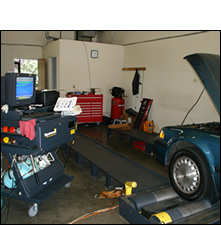 |
||||||||||||||||||||||||||||||||
|
|

|
|
|
3. Lean Fuel Mixture - Any condition which will cause unmetered air to enter the intake manifold, and ultimately the combustion chambers, will cause high hydrocarbons (HC). This condition is called a lean miss-fire. Such faults as vacuum leaks and gasket leaks will cause lean fuel/air mixtures. Broken, disconnected or misrouted vacuum hoses will do the same. It is also important to note that many engine components rely on engine vacuum for proper operation. If any of these components are defective, externally or internally, they may cause large vacuum leaks as well. A good example of such a component is your vehicle's power brake booster.
4. Defective Catalytic Converter - A defective catalytic converter (CAT) may be responsible for high HC, CO, and NOx emissions. The Catalytic Converter, commonly referred to as the CAT is a component designed to continue the combustion process within itself and emit a more thoroughly burned and less harmful emissions containing exhaust. The most accurate way to find out if your vehicle's CAT is working efficiently is by using an exhaust gas analyzer. Unfortunately this tool is fairly expensive. Testing the CAT should be conducted at a smog check repair station. Some obvious symptoms of a bad CAT could be any of the following: a. Major loss of power over 15-25 mph. This may be an indication that the catalytic converter is plugged up and restricting exhaust flow. b. Strong sulfer or rotten egg smell emitting from the exhaust on an otherwise good running vehicle. This may be an indication that the Catalytic Converter isn't burning fuel completely, instead storing it, then releasing it as hydrogen sulfide. c. Loud rattle being heard from inside the CAT. This may indicate a broken Catalytic Converter substrate. You may want to ensure this sound is not due to loose exhaust components, i.e. broken muffler flanges, loose exhaust pipes, loose or cracked exhaust manifold. 5. Defective Air Injection Components - Faulty smog pump and related emissions system components will cause high HC. The air injection system is designed to introduce additional oxygen, after the metering system, to the engine exhaust as it exits the exhaust manifold, or directly before it enters the Catalytic Converter; thus burning whatever remaining fuel (HC) in the exhaust completely.
6. Low Cylinder Compression - This fault is one of the less common high HC causing problems we encounter. Reasons an engine may have low or no compression in one or more of its cylinders may include things such as burned intake or exhaust valve/s, defective valve guides and/or seals, defective piston rings, and burned head gasket/s. A wet/dry cylinder compression test will diagnose this fault. More then often if such a problem exists it will be very apparent. You should notice rough idle.
|